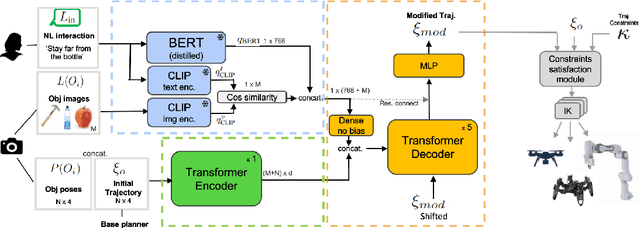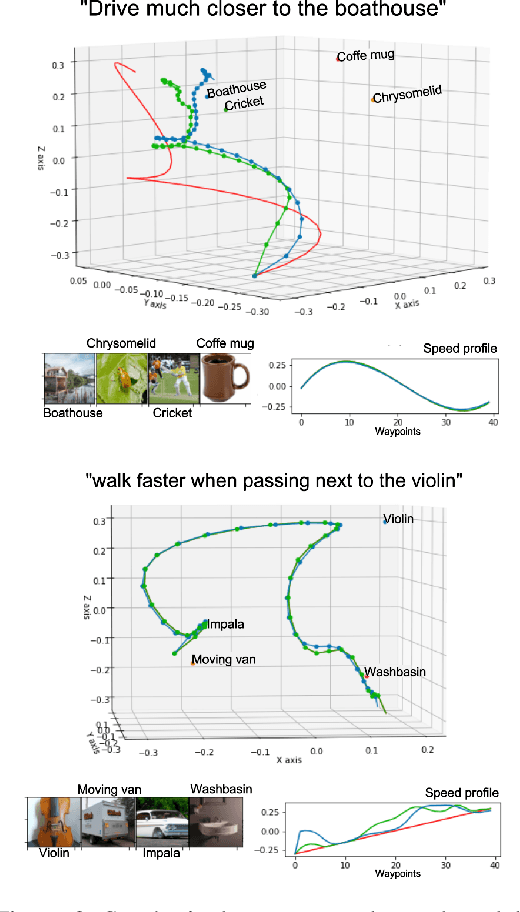Luis Figueredo
GeoPF: Infusing Geometry into Potential Fields for Reactive Planning in Non-trivial Environments
May 26, 2025Abstract:Reactive intelligence remains one of the cornerstones of versatile robotics operating in cluttered, dynamic, and human-centred environments. Among reactive approaches, potential fields (PF) continue to be widely adopted due to their simplicity and real-time applicability. However, existing PF methods typically oversimplify environmental representations by relying on isotropic, point- or sphere-based obstacle approximations. In human-centred settings, this simplification results in overly conservative paths, cumbersome tuning, and computational overhead -- even breaking real-time requirements. In response, we propose the Geometric Potential Field (GeoPF), a reactive motion-planning framework that explicitly infuses geometric primitives - points, lines, planes, cubes, and cylinders - into real-time planning. By leveraging precise closed-form distance functions, GeoPF significantly reduces computational complexity and parameter tuning effort. Extensive quantitative analyses consistently show GeoPF's higher success rates, reduced tuning complexity (a single parameter set across experiments), and substantially lower computational costs (up to 2 orders of magnitude) compared to traditional PF methods. Real-world experiments further validate GeoPF's robustness and practical ease of deployment. GeoPF provides a fresh perspective on reactive planning problems driving geometric-aware temporal motion generation, enabling flexible and low-latency motion planning suitable for modern robotic applications.
Geometrically-Aware One-Shot Skill Transfer of Category-Level Objects
Mar 19, 2025Abstract:Robotic manipulation of unfamiliar objects in new environments is challenging and requires extensive training or laborious pre-programming. We propose a new skill transfer framework, which enables a robot to transfer complex object manipulation skills and constraints from a single human demonstration. Our approach addresses the challenge of skill acquisition and task execution by deriving geometric representations from demonstrations focusing on object-centric interactions. By leveraging the Functional Maps (FM) framework, we efficiently map interaction functions between objects and their environments, allowing the robot to replicate task operations across objects of similar topologies or categories, even when they have significantly different shapes. Additionally, our method incorporates a Task-Space Imitation Algorithm (TSIA) which generates smooth, geometrically-aware robot paths to ensure the transferred skills adhere to the demonstrated task constraints. We validate the effectiveness and adaptability of our approach through extensive experiments, demonstrating successful skill transfer and task execution in diverse real-world environments without requiring additional training.
Motion Planning for Robotics: A Review for Sampling-based Planners
Oct 28, 2024Abstract:Recent advancements in robotics have transformed industries such as manufacturing, logistics, surgery, and planetary exploration. A key challenge is developing efficient motion planning algorithms that allow robots to navigate complex environments while avoiding collisions and optimizing metrics like path length, sweep area, execution time, and energy consumption. Among the available algorithms, sampling-based methods have gained the most traction in both research and industry due to their ability to handle complex environments, explore free space, and offer probabilistic completeness along with other formal guarantees. Despite their widespread application, significant challenges still remain. To advance future planning algorithms, it is essential to review the current state-of-the-art solutions and their limitations. In this context, this work aims to shed light on these challenges and assess the development and applicability of sampling-based methods. Furthermore, we aim to provide an in-depth analysis of the design and evaluation of ten of the most popular planners across various scenarios. Our findings highlight the strides made in sampling-based methods while underscoring persistent challenges. This work offers an overview of the important ongoing research in robotic motion planning.
Using The Concept Hierarchy for Household Action Recognition
Sep 13, 2024Abstract:We propose a method to systematically represent both the static and the dynamic components of environments, i.e. objects and agents, as well as the changes that are happening in the environment, i.e. the actions and skills performed by agents. Our approach, the Concept Hierarchy, provides the necessary information for autonomous systems to represent environment states, perform action modeling and recognition, and plan the execution of tasks. Additionally, the hierarchical structure supports generalization and knowledge transfer to environments. We rigorously define tasks, actions, skills, and affordances that enable human-understandable action and skill recognition.
Learning Barrier-Certified Polynomial Dynamical Systems for Obstacle Avoidance with Robots
Mar 13, 2024Abstract:Established techniques that enable robots to learn from demonstrations are based on learning a stable dynamical system (DS). To increase the robots' resilience to perturbations during tasks that involve static obstacle avoidance, we propose incorporating barrier certificates into an optimization problem to learn a stable and barrier-certified DS. Such optimization problem can be very complex or extremely conservative when the traditional linear parameter-varying formulation is used. Thus, different from previous approaches in the literature, we propose to use polynomial representations for DSs, which yields an optimization problem that can be tackled by sum-of-squares techniques. Finally, our approach can handle obstacle shapes that fall outside the scope of assumptions typically found in the literature concerning obstacle avoidance within the DS learning framework. Supplementary material can be found at the project webpage: https://martinschonger.github.io/abc-ds
LoHoRavens: A Long-Horizon Language-Conditioned Benchmark for Robotic Tabletop Manipulation
Oct 23, 2023



Abstract:The convergence of embodied agents and large language models (LLMs) has brought significant advancements to embodied instruction following. Particularly, the strong reasoning capabilities of LLMs make it possible for robots to perform long-horizon tasks without expensive annotated demonstrations. However, public benchmarks for testing the long-horizon reasoning capabilities of language-conditioned robots in various scenarios are still missing. To fill this gap, this work focuses on the tabletop manipulation task and releases a simulation benchmark, \textit{LoHoRavens}, which covers various long-horizon reasoning aspects spanning color, size, space, arithmetics and reference. Furthermore, there is a key modality bridging problem for long-horizon manipulation tasks with LLMs: how to incorporate the observation feedback during robot execution for the LLM's closed-loop planning, which is however less studied by prior work. We investigate two methods of bridging the modality gap: caption generation and learnable interface for incorporating explicit and implicit observation feedback to the LLM, respectively. These methods serve as the two baselines for our proposed benchmark. Experiments show that both methods struggle to solve some tasks, indicating long-horizon manipulation tasks are still challenging for current popular models. We expect the proposed public benchmark and baselines can help the community develop better models for long-horizon tabletop manipulation tasks.
A Concise Overview of Safety Aspects in Human-Robot Interaction
Sep 18, 2023



Abstract:As of today, robots exhibit impressive agility but also pose potential hazards to humans using/collaborating with them. Consequently, safety is considered the most paramount factor in human-robot interaction (HRI). This paper presents a multi-layered safety architecture, integrating both physical and cognitive aspects for effective HRI. We outline critical requirements for physical safety layers as service modules that can be arbitrarily queried. Further, we showcase an HRI scheme that addresses human factors and perceived safety as high-level constraints on a validated impact safety paradigm. The aim is to enable safety certification of human-friendly robots across various HRI scenarios.
Towards Language-Based Modulation of Assistive Robots through Multimodal Models
Jun 27, 2023
Abstract:In the field of Geriatronics, enabling effective and transparent communication between humans and robots is crucial for enhancing the acceptance and performance of assistive robots. Our early-stage research project investigates the potential of language-based modulation as a means to improve human-robot interaction. We propose to explore real-time modulation during task execution, leveraging language cues, visual references, and multimodal inputs. By developing transparent and interpretable methods, we aim to enable robots to adapt and respond to language commands, enhancing their usability and flexibility. Through the exchange of insights and knowledge at the workshop, we seek to gather valuable feedback to advance our research and contribute to the development of interactive robotic systems for Geriatronics and beyond.
Human-to-Robot Manipulability Domain Adaptation with Parallel Transport and Manifold-Aware ICP
Aug 16, 2022



Abstract:Manipulability ellipsoids efficiently capture the human pose and reveal information about the task at hand. Their use in task-dependent robot teaching - particularly their transfer from a teacher to a learner - can advance emulation of human-like motion. Although in recent literature focus is shifted towards manipulability transfer between two robots, the adaptation to the capabilities of the other kinematic system is to date not addressed and research in transfer from human to robot is still in its infancy. This work presents a novel manipulability domain adaptation method for the transfer of manipulability information to the domain of another kinematic system. As manipulability matrices/ellipsoids are symmetric positive-definite (SPD) they can be viewed as points on the Riemannian manifold of SPD matrices. We are the first to address the problem of manipulability transfer from the perspective of point cloud registration. We propose a manifold-aware Iterative Closest Point algorithm (ICP) with parallel transport initialization. Furthermore, we introduce a correspondence matching heuristic for manipulability ellipsoids based on inherent geometric features. We confirm our method in simulation experiments with 2-DoF manipulators as well as 7-DoF models representing the human-arm kinematics.
LaTTe: Language Trajectory TransformEr
Aug 09, 2022



Abstract:Natural language is one of the most intuitive ways to express human intent. However, translating instructions and commands towards robotic motion generation, and deployment in the real world, is far from being an easy task. Indeed, combining robotic's inherent low-level geometric and kinodynamic constraints with human's high-level semantic information reinvigorates and raises new challenges to the task-design problem -- typically leading to task or hardware specific solutions with a static set of action targets and commands. This work instead proposes a flexible language-based framework that allows to modify generic 3D robotic trajectories using language commands with reduced constraints about prior task or robot information. By taking advantage of pre-trained language models, we employ an auto-regressive transformer to map natural language inputs and contextual images into changes in 3D trajectories. We show through simulations and real-life experiments that the model can successfully follow human intent, modifying the shape and speed of trajectories for multiple robotic platforms and contexts. This study takes a step into building large pre-trained foundational models for robotics and shows how such models can create more intuitive and flexible interactions between human and machines. Codebase available at: https://github.com/arthurfenderbucker/NL_trajectory_reshaper.
 Add to Chrome
Add to Chrome Add to Firefox
Add to Firefox Add to Edge
Add to Edge